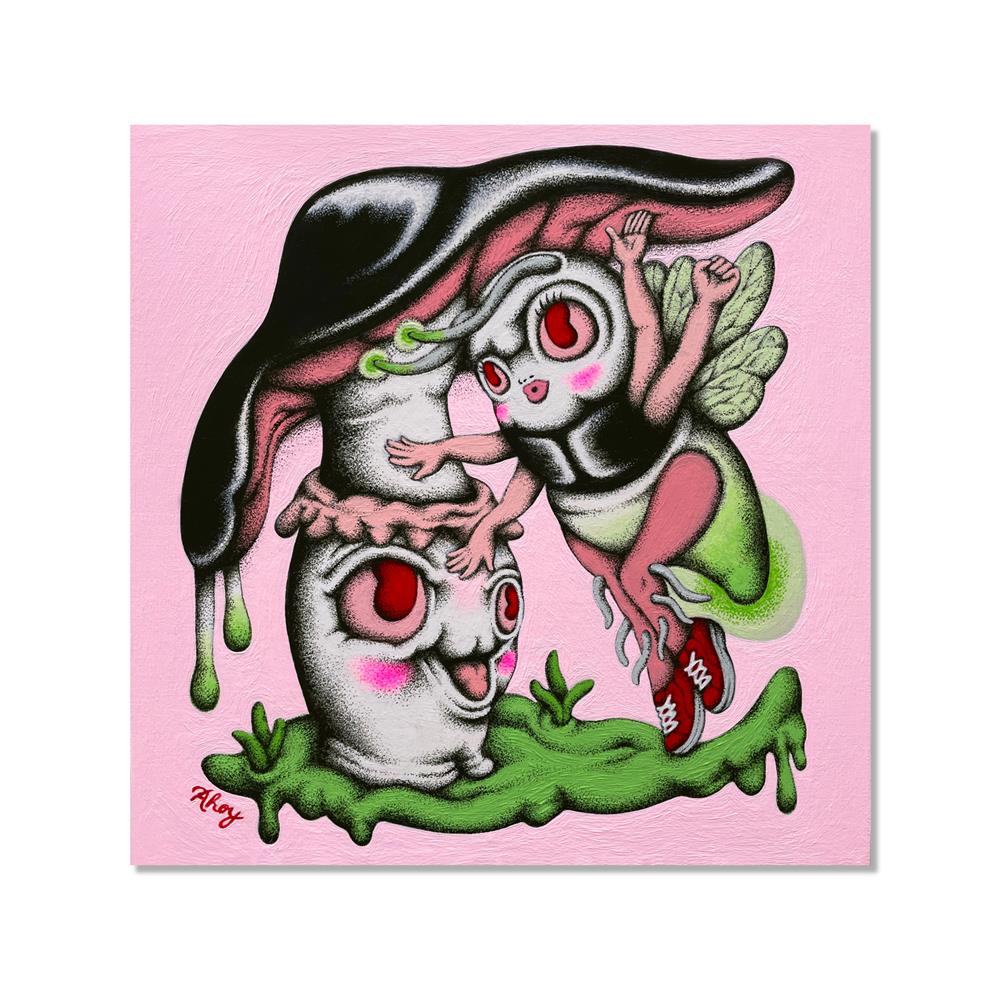18 june 2024, Wouter van den Eijkel
Last chance: Popland IV
French pop surrealist Ciou curated Popland for the fourth time, bringing together no fewer than 21 leading artists from this movement and making the show a unique overview of everything the genre has to offer. The participating artists are Ahoy, Alexandra Lukaschewitz, Briana Hertzog, Creaturecreature, Chuck Sperry, Dilka, El Gato Chimney, Erlend Tait, Jana Brike, Junko Mizuno, Malojo, Mizna Wada, Mono Cieza, Naoto Hattori, Pamela Tait, Peca, Peter ter Mors, Travis Lampe, Travis Louie, Yu Maeda and curator Ciou.
“We don’t sell all of the works online, so a few remain available in the Netherlands,” says Esther Koch, pointing to one of the three panels by Chuck Sperry. The American artist has made a name for himself in recent decades as a designer of psychedelic screen prints and concert posters, often featuring women with flower crowns on their heads against a floral background. “There are even bots crawling the internet to see if his work is for sale, and if it is, it’s sold out within a minute.”
You might expect this more from a phenomenon like Kaws, but Sperry is part of a movement known as Pop Surrealism, a niche that isn’t very large in the Netherlands, but has many enthusiasts internationally. Hence the ‘Price on request’ button for his work. Pop surrealism is an art movement that emerged in the late 20th century, with work that often contains a narrative featuring imaginative, playful elements of satire and criticism of society, culture and consumerism. The art often includes iconography and symbols from various subcultures. Pop-surrealist work also shows a high level of technical skill and detail.

Chuck Sperry, Leto, 2024, Koch x Bos Gallery
Like the enthusiasts and collectors, the artists in this movement come from all corners of the world. The fourth edition of Popland, like the first three, was curated by French artist Ciou. In addition to her work, there is also work from artists from Japan, Hong Kong, Australia, Spain, Lithuania, the United States, Argentina, the Netherlands, Scotland and Germany.

CreatureCreature, Infinite Loop, Koch x Bos Gallery
A well-known figure in this movement, Ciou helped bring work by artists to the Netherlands, Koch explains in the gallery. “We get work from CreatureCreature (Australia) through her recommendation. Otherwise, they might not have sent work to the Netherlands so easily.” Because Popland uses an insider’s network, you not only get to see work that might otherwise not be available, but also relevant developments within this movement.
Ciou did not adhere to a specific theme for the selection and let the artists create whatever they wanted. Still, the works form a whole because the artists are united by the same influences. The Frenchwoman points out in the press release that anime, pop culture and ‘folk art’ are sources of inspiration. These are representations that cannot occur in reality, such as the woman with a purple dragon head by Briana Herzog or the introverted child sitting on a stone head by Dilka Bear.

Junko Mizuno, Women's Truck, 2024, Koch x Bos Gallery
Women's truck
In terms of content, the work is sometimes more political and socially engaged than you might expect based on the title and sources of inspiration, thus aligning with the regular programming of Koch x Bos, where pop culture and humour are often combined with a political or emancipatory message. This combination is evident in the work Women’s Truck by Japanese Junko Mizuno, which, in addition to clear references to anime and pop culture, also carries an emancipatory charge.
“Since the 1970s, there has been a fascinating culture of flamboyantly decorated trucks in Japan. I always wanted to draw my version of a Japanese decorated truck with my characters on it. This is Women’s Truck, which only drives on full moon nights. No one knows what they are transporting, but there always seems to be a crazy party going on inside. It is known as a sign of good luck if you see it driving on the street,” says Mizuno. At first glance, there is little political about a dekotora for Western viewers, as the cars are called in Japan. The anime female figures are smoking a cigarette, but those who understand Japanese will realise that the work is about the relationship between men and women. It reads: woman/women, dream, love, everlasting, ecstatic, invincible.

Popland IV, Koch x Bos Gallery
Game of Shrooms
The works of Ahoy, Angela Ho’s pseudonym, look peaceful – mushrooms winking – but the meaning could hardly be more political. Ho was invited in 2019 to participate in Game of Shrooms, an annual worldwide event in which people hide their homemade mushroom art for others to find.
Ho made risoprints of a parasol mushroom protecting smaller mushrooms and puffballs spreading their spores defiantly. On the day she hid her prints, the largest protest in Hong Kong’s history took place, with two million people protesting against an extradition law and the growing influence of the Chinese Communist Party on Hong Kong's government. Protests continued in Hong Kong that year. The pandemic put an end to that. Since then, the CCP has tightened its grip on Hong Kong, thousands of people have been arrested and members of the opposition are imprisoned, still awaiting their trial or have left Hong Kong in self-imposed exile. Ho addresses the latter in Diaspora Growth Spurt (2023).
“The symbolism of mushrooms is now intrinsically linked for me with movements representing freedom from authoritarianism and oppression, and the connectivity and diaspora of all people who desire this, comparable to a spore network.” In The Shroom and the Firefly (2023), the mushrooms form a visual metaphor for the umbrellas that became a symbol of the protests. The mushroom protects the firefly, representing the hope of the Hongkongers.
Popland IV – curated by Ciou – can be seen until Saturday 29 June at Koch x Bos Gallery in Amsterdam.

AHoy, The Shroom And The Firefly, Koch x Bos Gallery
